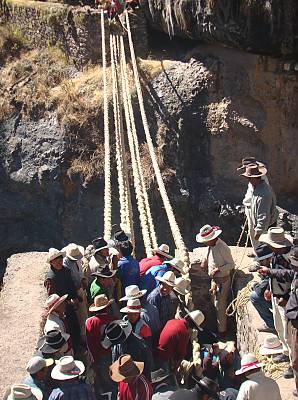Knowledge, skills and rituals related to the annual renewal of the Q’eswachaka bridge (جاري عملية الترجمة)
سجل في (8.COM) على القائمة التمثيلية للتراث الثقافي غير المادي للبشرية
بلد(ان): بيرو
تعريف
Description

- Knowledge, skills and rituals related to the annual renewal of the Q’eswachaka bridge
- © 2010 by National Institute of Culture
عذراً، هذه الصفحة غير متوفرة باللغة العربية
The Q’eswachaka bridge is a rope suspension bridge over a gorge of the Apurimac River in the southern Andes. It is renewed every year, using traditional Inca techniques and raw materials. The Quechua-speaking peasant communities of Huinchiri, Chaupibanda, Choccayhua and Ccollana Quehue see it as a means of strengthening their social links and not simply as a transport route. The bridge is considered a sacred expression of the communities’ bond with nature, tradition and history, and the annual renewal is accompanied by ritual ceremonies. Although the renewal lasts only three days, it structures the life of the participating communities all year round, establishing communication, strengthening centuries-old bonds and reaffirming their cultural identity. The process begins with families cutting and twisting straw to form thin ropes about 70 m long. Two bridge-builders then guide the process of twisting them together to form medium-sized ropes, which are then braided to form six great ropes. When these are ready, men from the community tie the ropes tightly to ancient stone bases. The craftspeople then lead the weaving of the bridge, each starting from opposite ends. Once finished, the communities hold a celebratory festival. The techniques of bridge weaving are taught and learned within the family circle.مستندات
عرض الشرائح
فيديو
© 2010, Ministry of Culture
يمكن استعراض مقاطع الفيديو هذه (بالإضافة إلى العديد غيرها) من خلال موقع أرشيف اليونسكو للملتميديا”











